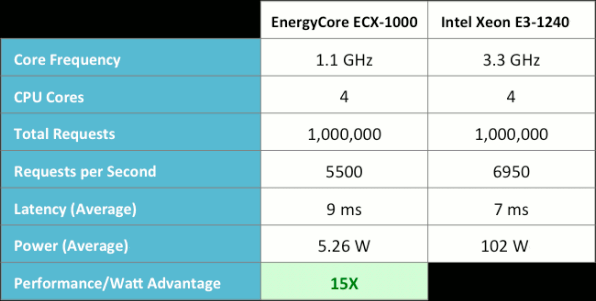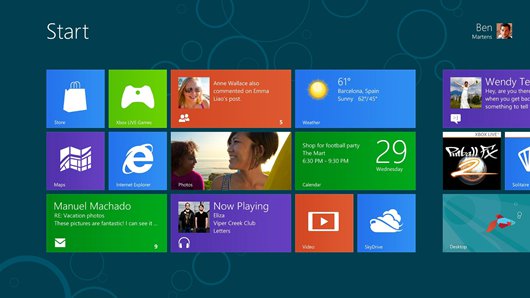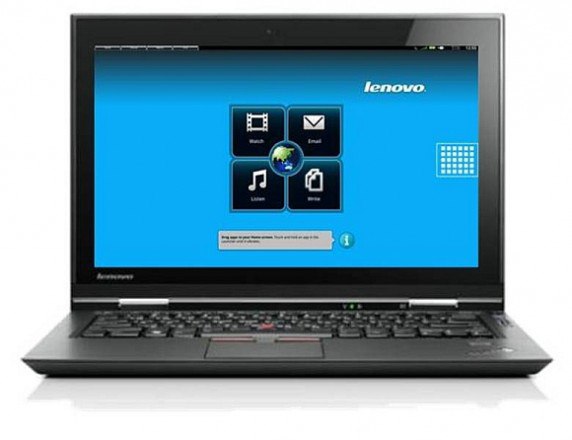Calxeda has released the results of ApacheBench benchmark comparing their ARM-based EnergyCore solution to an Intel Xeon server in order to showcase the performance and the much lower power consumption of their servers. Here’s the setup: Hardware: Single Calxeda EnergyCore ECX-1000 @ 1.1 GHz, 4 GB of DDR3L-1066 memory, 1Gb Ethernet network port and 250 GB SATA 7200rpm HDD Intel Xeon E3-1240 @ 3.3 GHz, 16 GB memory and 1Gb Ethernet network port. No info on hard drive provided Software: Ubuntu Server v12.04 Apache Server v2.4.2 ApacheBench v2.3 (16k request size) They performed power measurements every 2 seconds and averaged the results. Power supply overhead and hard drive power consumption were not excluded in the measurement, but the entire SoC and DDR memory power consumption were included together. For the Intel server however, they could not measure directly, so they used published TDP values for the CPU (80 W) and I/O […]
Intel Roadmap to 2015 and Beyond: 5nm Technology, Merrifield Mobile Processor, Microservers and More
Intel had their annual Investor meeting day on the 10th of May 2012 in Santa Clara where we would learn a few things about what’s ahead for Intel and the semiconductor industry. Paul Otellini, Intel President and Chief Executive Officer, started the meeting by giving some numbers about Intel results and showing opportunities existing for cloud and data center, personal computing, mobile devices and intelligent systems (for automotive, retail and communications markets). One interesting point was the tremendous growth in data Intel expects from 2,500 Exabytes per year (7 EB/day) today to 8,000 Exabytes by 2015 which the majority of the growth lead by Big data. He also boasted about Intel technology advantage. For example, Intel introduced High-K Metal Gate technology in 2007 and competitor only got it in products last year (btw Samsung Exynos 5 uses HKMG). They recently introduced Tri-gate technology and they only expect competitors to catch […]
Intel Announces Atom CE5300 Media Processor for STBs and Smart TVs
Intel announced the Atom CE5300 Media Processor (codenamed Berryville) to be used in set-top boxes and smart TVs at IPTV World Forum. This new processor is the replacement for CE4100, CE4130 and CE4150 media processors used in the D-Link Boxee Box and Sony NSX-24GT1 Google TV. The Intel Atom CE5300 Media Processor is manufactured using 32nm part and features a dual Intel Atom core with support for hyper-threading and virtualization, an advanced 3D/2D graphics engine, integrated power management, and an H.264 B-picture hardware encoder. That’s all we know for now, as Intel did not provide further information such as a product brief for their new SoC. The Amino Freedom Live Media Gateway, an Hybrid/OTT media gateway powered by the Intel Atom CE5300, is currently showcased at IPTV World Forum. This STB also features the latest Opera TV Browser that support HTML5, JavaScript and WebGL technology among other things. Jean-Luc Aufranc […]
Microsoft Unveils Windows 8 Consumer Preview at MWC 2012
Earlier this month, Microsoft announced they would be releasing Windows 8 Consumer Preview at the end of February, and they have done so yesterday with an official announcement at Mobile World Congress 2012, in Barcelona, Spain. During the event, they showcased ARM tablets based on Nvidia Tegra 3, Qualcomm Snapdragon S4 and Texas Instruments OMAP 4/5, as well as tablets, ultrabooks, laptops and touch PCs based on Intel meldfield and clove trail. All those devices are reference platform for developers and not actual products although Microsoft expect manufacturers to use those reference designs to build their products. The Touch PC used a an interesting screen which could be positioned vertically (like a normal screen). horizontally (like a surface PC) and at an angle for use cases such as an architecture reading a plan or an artist drawing a painting. They also showcased a very large touchscreen that could be used by […]
The Yocto Project Overview and Update – ELC 2012
Saul Wold, User Space Architect at Intel Open Source Technology Center, discusses the latest on the Yocto Project at the Embedded Linux Conference 2012. Abstract: The Yocto Project is a joint project to unify the world’s efforts around embedded Linux and to make Linux the best choice for embedded designs. The Yocto Project is an open source starting point for embedded Linux development which contains tools, templates, methods and actual working code to get started with an embedded device project. In addition, the Yocto Project includes Eclipse plug-ins to assist the developer. This talk gives a walk-through of the key parts of the Yocto Project for developing embedded Linux projects. In addition, features will be described from the latest release of Yocto. At the end of the talk, developers should be able to start their own embedded project using the Yocto Project and use it for developing the next great […]
Android and Tizen on Intel Medfield Atom Z2460 (Video Interview)
Intel announced the MedField Soc (Atom Z2460) targeted at smartphones and tablet and showcased a smartphone reference design running Android based on this platform. Mike Bell GM of Intel’s Mobile Communications Groups (MCG) has been interviewed by EETimes. He talks about Intel entry into the mobile phone market and explains that MedField boasts similar power consumption than top competitors with better performance (3 to 4 times faster in some web browser benchmark). He mainly talks on what they have done to port Android on the platform (and shows Angry Bird a lot) and what you may expect in the future. He also quickly mentioned Tizen. Here’s the original EETimes’ article. Jean-Luc Aufranc (CNXSoft)Jean-Luc started CNX Software in 2010 as a part-time endeavor, before quitting his job as a software engineering manager, and starting to write daily news, and reviews full time later in 2011. www.cnx-software.com
Intel or ARM NoteBook? Lenovo Says Both
Lenovo has announced the ThinkPad X1 Hybrid notebook which features an Intel Core processor (i3, i5, or i7 depending on the model) AND a Qualcomm Dual core ARM processor, allegedly a Qualcomm APQ8060 and runs both Windows 7 and a custom version of Linux. My first reaction when I read the news was: “What a stupid idea!” :~/ The ThinkPad X1 Hybrid has 13.3″ HD display with 1366×768 resolution and built with Gorilla Glass. The laptop also features an HD webcam, a fingerprint reader, an encrypted hard disk drive, an HDMI port, USB ports, and Intel’s Wireless Display (WiDi) technology. RapidCharge technology charges to 80% capacity in 30 minutes, i.e. approximately the time it takes to take a shower and cook an egg… (Not my idea, see promo video below). The only thing that can possibly justify having two different processors on the machine is the Instant Media Mode (IMM) […]
Enable OpenGL 2.0 and WebGL for Intel GMA3150 in Ubuntu
I wanted to use WebGL in my Acer Aspire One D255E netbook that uses an Intel GMA 3150 onboard graphics card, but it did not work in Chromium nor Firefox. WebGL requires OpenGL 2.0 support, but I found out I only had support for OpenGL 1.4:
|
1 2 |
glxinfo | grep -i "OpenGL version" OpenGL version string: 1.4 Mesa 7.7.1 |
But I found out it was possible to enable OpenGL 2.0 for GMA 3150 in Linux by installing and running driconf:
|
1 2 |
sudo apt-get install driconf driconf |
and clicking on “Enable limited ARB_fragment_shader support on 915/945.” and “Enable stub ARB_occlusion_query support on 915/945.” options. They are not enabled by default because they do cause problems. After those two options were enabled, OpenGL 2.0 was enabled.
|
1 2 |
glxinfo | grep -i "OpenGL version" OpenGL version string: 2.0 Mesa 7.7.1 |
But I still could not use WebGL in either Chromium nor Firefox, so I decided to install the latest version of Mesa (7.11) with indirect rendering (software) enabled with libOSMesa:
|
1 2 3 4 5 6 7 |
sudo apt-get install libffi-dev wget ftp://ftp.freedesktop.org/pub/mesa/7.11/MesaLib-7.11.tar.bz2 tar xjvf MesaLib-7.11.tar.bz2 cd Mesa-7.11 ./configure --enable-os-mesa --prefix=/usr make make install |
Even with the latest Mesa library, I could not use WebGL […]







